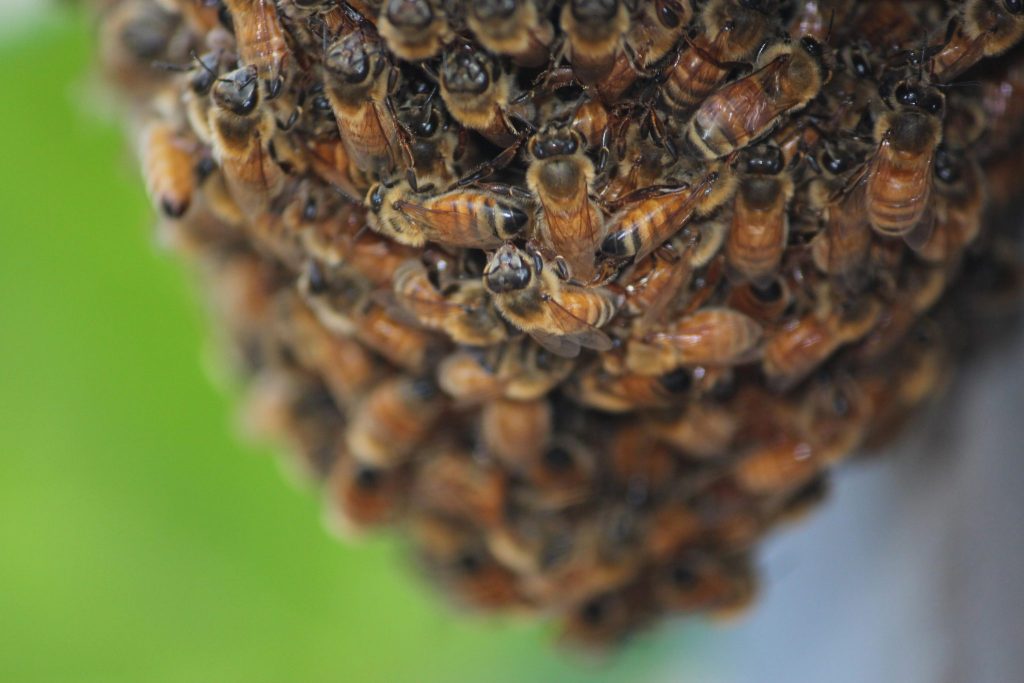Find a swarm collector
What are bee swarms?
A bee swarm is the result of the natural response to the reproductive process in bees occurring in the wild and in managed hives. It is a normal process for bees to swarm often in spring and summer in Canberra. Beekeepers who manage will reduce the risk of swarming through proper management techniques. It is the availability of ample nectar and pollen which creates the ideal conditions for bees to swarm. You can report a swarm using Swarmed.

Do I have a swarm in my yard?
Once half the bees and the queen leave their original home, they will fly to another location and cluster. Sometimes this is just a few metres from where they started; sometimes it is several hundred metres away. Often they will move to a tree, wall, fence, house eaves, or in rare cases on a motor cycle!
Should I be worried?
The sight of bees swarming can be unnerving to people yet a sting is unlikely as they’ve just gorged themselves on honey before departing and aren’t defending a nest. However, once the swarm settles, they may become less docile after a couple of days. In any case, it is best to leave swarming bees in peace unless you know what you’re doing.
Watch as this skilled beekeeper encourages all of the bees into the Nucleus box and she isn’t wearing any protective equipment. However, once again, it is best to avoid unnecessarily bothering a swarm and DON’T SPRAY ANY POISON!
What should I do if there is a bee swarm in my yard?
Once the swarm has clustered, scout bees will soon begin the search for a cavity such as a possum box, tree hollow, shed, house wall or water meter space in which to setup their new colony. Ideally you should contact a beekeeper to remove a swarm as soon as it is noticed, before the bees move into a cavity and establish.
It is useful to know some information like how long have the swarm been there, what size the cluster is and height off the ground.
How much does it cost to get rid of a bee swarm?
A bee swarm cluster on a branch at chest level is very different to an established colony of bees which have been living in your wall for a few years. The time taken to remove clustered bee swarms can range between 30 minutes to a full day. Removal of established colonies involves cutting out comb and therefore this is described as a ‘cut-out’. It is advisable to proceed with removal of established colonies also, rather than leave them be, as this removes the bees and the comb. There could be kilos of wax in your wall and this represents a significant fire hazard.
So how much does it cost to remove a bee swarm? Some beekeepers may collect swarms for free and then on-sell the colony once they have checked it for disease therefore obtaining a saleable product and have done the community a service while others charge a small few to cover costs such as petrol and insurance. Removal of an established colony is generally not something that beekeepers provide for free due to the effort involved and in fact such removals will likely cost hundreds (or even thousands) of dollars depending on how long the bees have been there.
Still need help? Contact our Bee Swarm or Bee Colony Collectors
Bee colonies can be located in unusual but common places such as bird boxes, possum boxes, letter boxes, house walls, roof cavities, sheds, dog houses, shoes, cars, outdoor speakers and any other small “Bee” spaces. Some beekeepers will only collect swarms while others will also remove established colonies that have already built comb.
Bee swarm collectors for the Canberra Region are trialling the Swarmed systems as has been adopted by Amateur Beekeepers Australia. If you report a swarm, a beekeeper registered on the site will within thier specified area will be notified and can get in contact. The people listed will be beekeepers who are current members of Amateur Beekeepers Australia (ABA) and also, most likely, members of the Canberra Region Beekeepers, depending on postcode.
All beekeepers listed on the ABA’s site have had the opportunity to purchase public liability for swarm collection through the ABA. Some may also have their own separate insurance. If concerned, please confirm this with the beekeeper when you contact them.
While some beekeepers will collect swarms for free, others may charge a small fee to cover their costs but this is considerably less than you will pay to have the swarm poisoned by a pest exterminator.
Live removal of established colonies (bees that have been in a location for some time and have built comb) requires specialist skills and is generally a paid job due to the time and effort involved. Please discuss this with the beekeeper when you contact them.
How to advertise as a Swarm Collector
If you are a current member of the Canberra Region Beekeepers Association and want to ‘bee’ notified about swarms please register with Swarmed as a beekeeper. The Amateur Beekeepers Australia (ABA) can be contacted for any questions about the system.
